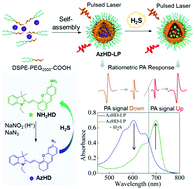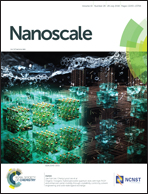Ratiometric photoacoustic nanoprobes for monitoring and imaging of hydrogen sulfide in vivo†
Abstract
Detection and visualization of hydrogen sulphide (H2S) is crucial for understanding its physiological and pathological roles towards human health and diseases, but precisely tracking of H2S in vivo remains challenging due to the limitations of available analytical methods. In this study, we developed a novel ratiometric photoacoustic (PA) nanoprobe for selective detection and imaging of H2S in biological fluids, live cells, brain tissues and animals. The nanoprobe AzHD-LP was fabricated by encapsulation of a newly synthesized H2S-responsive near-infrared (NIR) dye (AzHD) within a liposome (LP). The as-prepared AzHD-LP exhibits a dramatically red-shift response of its absorption peak after reduction reaction of AzHD with H2S: the absorbance of AzHD-LP centered at 600 and 700 nm is decreased and increased, respectively, producing a turn-on ratiometric PA signal in the presence of H2S. Typically, under the excitation of a 532 nm and 700 nm pulsed laser, the selective detection and imaging of H2S was achieved in aqueous solution, living cells and brain tissues of Alzheimer's diseased mice. Moreover, after AzHD-LP conjugated with a tumor-targeting peptide – c(RGDyK) as RGD-AzHD-LP – ratiometric PA mapping of the intratumoral generated H2S in the HCT116 colon tumor-bearing live mice was demonstrated.



 Please wait while we load your content...
Please wait while we load your content...